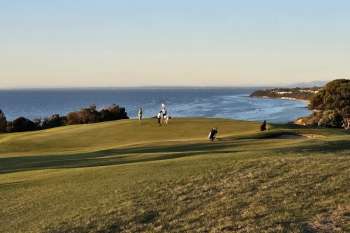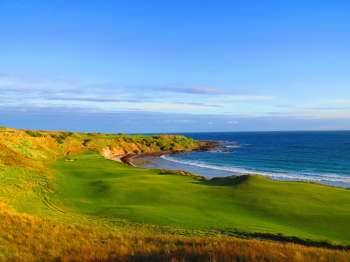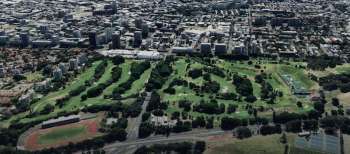Man on a Mission - Greenwood aims to take Peninsula to the top
Ask managers or golf club committees what their members want most out of their golf course, and many will channel Bill Clinton’s famous Presidential motif and tell you that, ‘it’s the conditioning, stupid.’ This is especially true at the Peninsula Country Golf Club, located in Frankston but part of Melbourne’s celebrated Sandbelt community.
Despite first-class amenities, quality design and arguably the second best piece of golfing ground in the city, behind Royal Melbourne, Peninsula doesn’t carry the same cachet as its more illustrious colleagues. This is chiefly because the conditioning of its North and South courses has failed to match standards set elsewhere on the Sandbelt. Both sit comfortably inside Australia’s Top 50 courses, but are clearly capable of significant improvement.
Enter Martin Greenwood, one of the best-credentialed and most celebrated turf professionals in the country. After a glittering 14-year career as Kingston Heath’s head superintendent, which included taking the course to No. 1 on Australian Golf Digest’s Top 100 rankings, in September Greenwood was appointed to the same role at Peninsula. His task, very simply, to improve the conditioning of the courses and elevate the status of the golf club.
The signs are already there; that what seemed a major coup for Peninsula is going to pay rich dividends. The turf has improved noticeably and, according to General Manager Gary Richardson, the members are excited about their future prospects. ‘It’s amazing what has already been achieved’ said Richardson. ‘Martin is building on all the work done over the past decade and quickly helping us realise the potential of being one of the top clubs in the country.’
Australian Golf Digest recently sat down with Martin Greenwood to discuss his career in the turf industry as well as the challenge of his new role at Peninsula.
Martin Greenwood:
I started in the industry at the Sale golf course as a mechanic. Soon after I was offered an apprenticeship in turf management, and in just my second year of the apprenticeship I was offered the superintendent’s position. This came about because we lost all of the greens at Sale. It was during a serious drought when salt levels rose in the Gippsland lakes and we killed all the greens by continuing to pump water onto them. So I became superintendent which was fantastic but also difficult - chiefly because the previous superintendent was not laid off, he was just demoted under me.
Graeme Grant and John Spencer helped rebuild all the greens at Sale. Both were really good to me, and at the end of the whole thing I asked them to give me a call if any jobs came up in Melbourne. Out of the blue I got a call from John Sloan at Woodlands looking for an assistant. I came down, had the interview and got the job.
After spending five years under John at Woodlands I went briefly to Kingston Heath in 1989 to help prepare for the Australian Open and then off to Gainsborough Greens in Queensland. While there I ran into Doug Robinson who was looking for someone for a golf course called Eastern Star in Thailand. Site unseen, my wife and I flew over there for a 6-month contract. We ended up spending two years in Thailand and another three in Malaysia.
In Thailand when I first got there I had 250 staff. When they used to clock on, there would be one person with 20 cards in his hand trying to clock 20 people on. You could be damn sure that you wouldn’t see any of them all day. I had dozens of people with clipboards going around trying to find these people. The only way I could get control of it was to bring in really strict rules. If you got caught clocking somebody on, everybody in your hand, plus yourself, were sacked. Pretty soon I’d cut out the blatant rorting and learned that you need to put rules in place and not to compromise on them.
What I did realize when I had 250 staff was the Asian mentality of ‘don’t worry about how much labour costs because labour is cheap’ was wrong. If you’ve got 250 of them it’s not cheap, especially if they aren’t doing what you want. During my time in charge I dropped the number down from 250 to 80, and that was for a 36-hole complex, which in Asia back then was very skinny. But we invested a lot in training, in discipline and in trying to get the guys playing golf and understanding the game. Asia developed me as a manager probably better than I realised at the time.
After I came back to Melbourne I sat on a bunker rake at Victoria for 6 months, and then spent a year as a client representative at Sanctuary Lakes. I initially went to Kingston Heath on the ground staff, but after Graeme Grant moved on (in 1998) they advertised the position and I got the job.
Kingston Heath being ranked number 1 in Australia in 2010 was a definite career highlight. In terms of big-ticket items in golf, however, it doesn’t get any bigger than the Masters in 2009. That was huge. Surprisingly it was good fun as well. It was exhausting, but while we had our hiccups behind the scenes the whole thing went flawlessly for us.
Tiger Woods made some comments about the greens, about how he thought they were a little more receptive than he was expecting. We were trying our hardest to firm them up but at the same time the PGA were saying they want the greens at 10.5 - 11 feet.
One of the things that really annoys me about tournament golf in Australia at the moment, is the way green speeds are being managed. They want them to be slow so the balls don’t blow off the greens, going back to La Perouse and Royal Melbourne and certainly Victoria, but I think they’ve got to have more confidence in the clubs and the superintendent that they are dealing with as far as pin placements are concerned. At Kingston Heath the ball won’t blow of the greens if the pin placements are in the right spot, but they don’t come to you and ask where to put the pins.
We actually prepared the greens faster and with harder pin placements for the club championships than we did for the number 1 golfer in the world. It was just stupid. And you talk to the professionals and they all say, ‘when are you going to speed the greens up.’ The professionals want them faster, the clubs want them faster but all the PGA want is a trouble free tournament.
After I left Kingston Heath I was fairly disillusioned with the industry and just wanted to draw breath and take a break. After about a month Peninsula contacted me through John Sloan and asked if I could help them as a contractor on a big dam project. I always thought this was a great piece of land, and it was always on the list of great golf courses to look after so when the superintendent position became available I applied.
In terms of improvement, I think the sky’s the limit with this place, or more importantly the budget’s the limit. The turf quality can be improved quite a bit and the most important thing is to get the greens firmer. Getting them back to pure bent grass is key.
I struggled for a long time at Kingston Heath to get the greens firm, and I’m doing the same things I did there and the greens at Peninsula are firming up so I think the particle size in the sand here is probably a little bit better and they’ve really taken well to both top dressing and sand injection. So we’ll get them pure first and then once we’ve got a pure canvas to play with we’ll work on getting them firmer and putting truer.
These golf courses on the Sandbelt have evolved and been designed for firm greens. Look at Woodlands. If it had soft, spongy greens it just wouldn’t be the golf course it is today. If you look at Peninsula, it already plays much differently to what it was. Players have got to use different shot selections, have to learn the bump and run or to move the ball around more. Kingston Heath is a great second shot golf course, and this course is probably more like that now than it ever has been – where there is a strong strategy to the way you play the hole. Part of that strategy is firm greens to put more difficulty onto that second shot. But the thing about firm greens, is you get as many complaints about rock hard greens as you do about soft greens.
In order for Peninsula to reach its potential there has to be a change of mindset from the ground staff and the management. I’m going to be putting a lot less water out, and will have a higher emphasis on hand watering. Also I don’t mind a dry scratchy green, if that’s the way we achieve the end goal. Sloan at Woodlands was a big influence on me. Those small, push up greens were dry and rock hard, and we used to spend a lot of time hand watering.
The other thing that needs to change here is the water quality. A lot of greens Victoria wide have changed their composition simply because of the quality of the water we are putting on. The impurities in the water can cause a lot of technical problems within the top 20-30mm and that’s what the dam project is all about. Eventually we will be using storm water, which is some of the best quality water you can get, and just having the recycled water as a backup. The plan is to build the dam over the Summer/Autumn period and have it ready for the Summer of 2013.
It was obvious when I got here, that there were plenty of people on staff who didn’t have a particularly strong golf or industry background. At Kingston Heath we had a really good array of people who were very keen on golf and I just didn’t see that here. We are trying to get them to understand the strategy of the game, and to get away from that, ‘you’ve got a job, do the job, tick, done, next’ mentality to instead, ‘do the job and do it really well’. A good example is cutting fairways. You cut them at 5-6 km per hour, or you can cut them at 10km/hr but they end up like a washboard.
Before I started here I was told that it’s really difficult to find good staff in Frankston, but it didn’t take long to discover that there are fantastic staff already here, they just needed training. I take my hat of to the guys that I’ve got, they’ve changed their ways a lot and although they still need tweaking we are heading in the right direction. The productivity we are getting out them now is much better, the skill levels are lifting and you can get good staff in this area it’s just a case of treating them right and giving them the framework to do that work.
From a staff of 250 people looking after two courses I’m now down to 23 for 36 holes. Those numbers have come down even since I started, but we are actually getting more done.
So far the committee at Peninsula, either consciously or otherwise, have not put a lot on me in terms of reporting and the clerical side of things. At Kingston Heath you could end up spending 60-70% of your time in the office and in that case the people under you tend to run the golf course, which can be a trap. I’ve been in this industry a long time and I love golf courses. I also love pristine turf and I like to see that evolution of the turf. And sometimes you just end up in an office away from it all and you tend to miss things. When I interviewed here I said that I didn’t want to be a desk-bound superintendent, especially with 36 holes. I told them I wanted to play golf once a week, and get out there and experience the things the members are experiencing. I think if I can achieve this I’m serving the members better than sitting in an office shuffling papers around.
If you envisage Peninsula with Kingston Heath quality turf then you are going to have two very special golf courses and that’s what I’m aiming for. For the average member, the quality of the turf places fairly high on their enjoyment of the round and my intention is to give them the best quality turf I can so they can enjoy their golf more.
I’ve had my time in the sun at Kingston Heath. A lot of people aspire to be superintendent at those types of clubs, but a lot of baggage goes with those jobs. You’re the gatekeeper for a lot of history and a lot of tradition and the responsibility can be quite big. The committees also have a firm hand of what goes on. Dealing with a club like this is like a breath of fresh air. I seriously think this is one of the best jobs in the country and I’m loving every minute of it.
Interview by - Darius Oliver, Architecture Editor
Back to NewsMore News
Report reveals golf's $3.3 billion contribution to Australia
AGIC report reveals total annual benefits to the Australian community, economy and environment from golf.
Cape Wickham Links – The Inside Design Story
Co-designer Darius Oliver reveals the truth behind the design of Australia’s premier modern golf course
Min Woo Lee signs up for Aussie PGA title defence
Reigning champion locks in the defence of his title at Royal Queensland Golf Club in November
Have your say on the future of Moore Park Golf
Golfers unite – another one of our cherished public access golf courses is under threat




